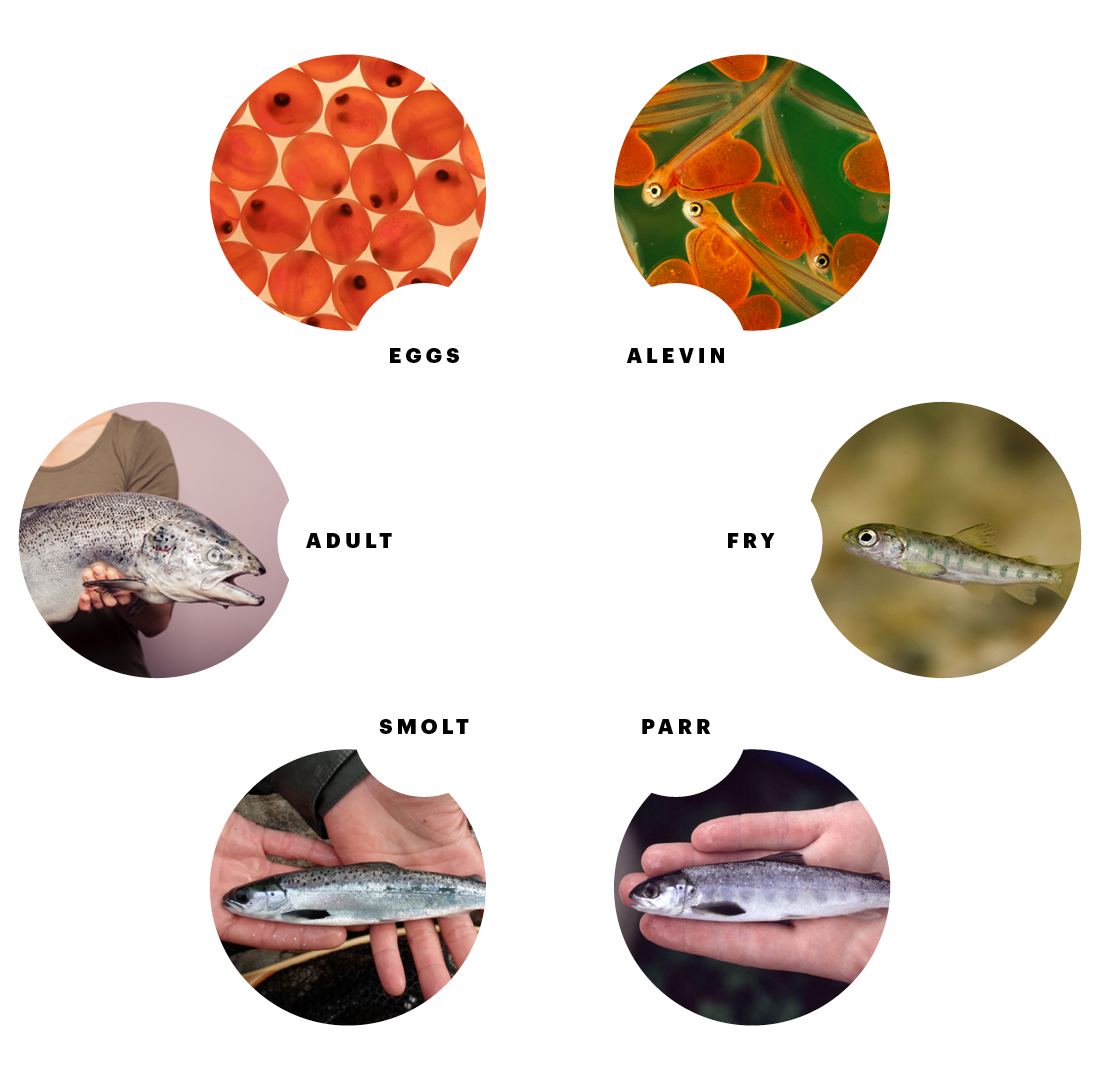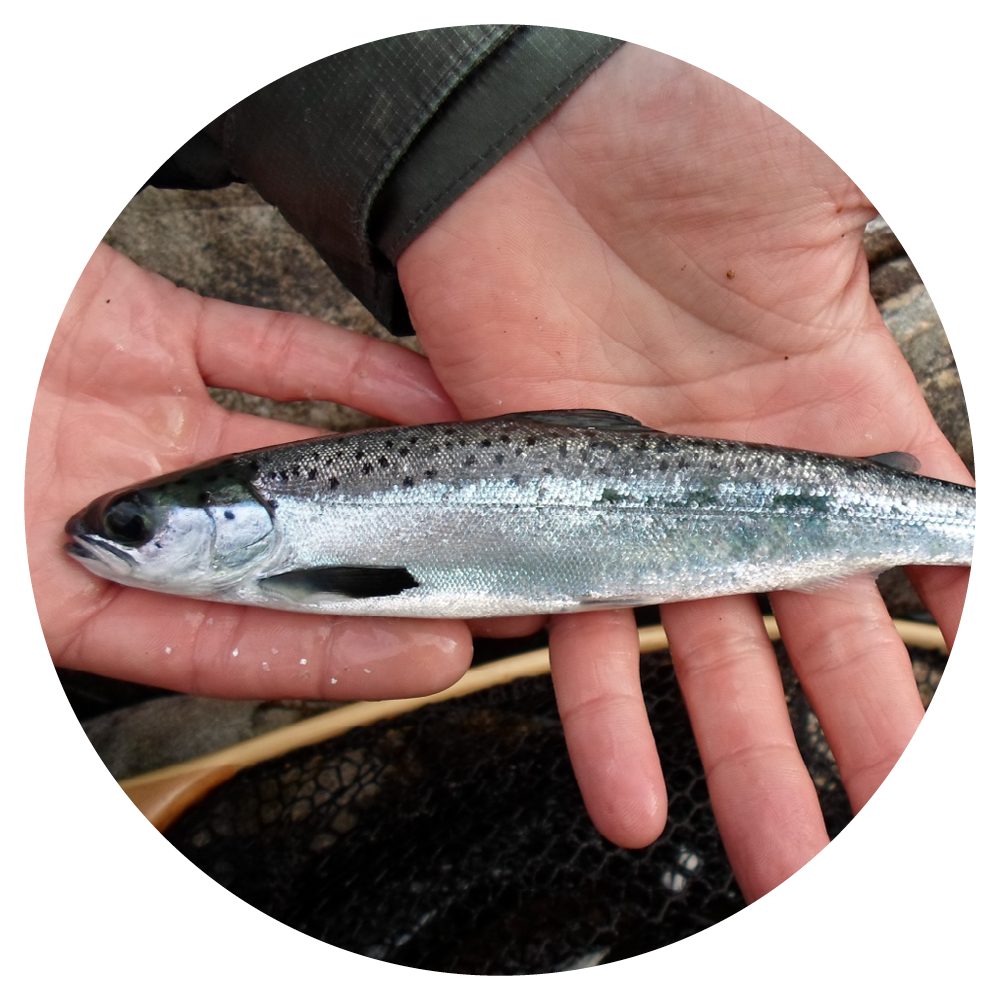
Salmon Life Cycle
The Atlantic salmon is an anadromous species of cold water fish, that is, it spawns in freshwater streams, and then the adults return to sea and the young salmon remain in fresh water for 2 or 3 years while they grow.
Atlantic salmon culture began in the 19th century in the UK in freshwater as a means of stocking waters with parr (young salmon) in order to enhance wild returns for anglers. Sea cage culture for growing fish, in what is now called aquaculture, was first used in the 1960s in Norway to raise Atlantic salmon to marketable size. Recirculating aquaculture systems make it possible to farm salmon entirely on land, replicating the natural wild environment and which is an ongoing initiative in the industry.

Stage 1: Egg
The lifecycle of the fish starts with laying down of eggs in the hatchery during the early winter months. Eggs and milt from selected parent breeding stock are mixed together to produce fertilised eggs.
The fertilised eggs are then placed in purpose-built incubators at specialised hatcheries where their environment aims to mimic egg incubation in the wild by providing substrate in which eggs can nestle and clean water flows, providing plenty of oxygen for the eggs to hatch and grow. The black dots that can be seen in the orange pea-sized eggs are the eyes of the salmon.
Stage 2: Alevin
The newly-hatched salmon are called 'alevins' and still have their yolk sac attached to their bodies.
These alevins become increasingly active when their yolk sac is absorbed while they develop all their organs and when strong enough, they rise to the surface of the water and gulp air. By doing this they fill their swim bladder to gain neutral buoyancy making it easier to swim and hold their position in fast-flowing streams that are replicated in the tanks. They remain in the hatching environment for another month or so at which time they are able to feed independently.

Stage 3: Fry
Once the hatchlings are able to feed independently they are referred to as ‘fry’ and are transferred to small freshwater tanks within the hatchery.
The fry have eight fins, which are used to maintain their position in fast-flowing streams and manoeuvre about in the water. They are extremely sensitive to changes in water quality, habitat and climate. Fry feed on microscopic invertebrates and their abundance is regulated by temperature, predation, pollution and competition for food with other fry and other species of fish.
Stage 4: Parr
The fry develop into parr with vertical stripes and spots for camouflage. They feed on aquatic insects and continue to grow for one to three years and once they have grown to between 10 and 25cm in body length, they undergo a physiological pre-adaptation to life in seawater by a natural process called smolting. This allows them to adapt to sea water and tolerate salt for the adult stage and to continue to feed and grow.
This is evident by changes in their appearance as they become silvery and swim with the current instead of against it. There are also internal changes in the salt-regulating mechanisms of the fish.

Stage 5: Smolt
When farmed Atlantic salmon are ready to be transferred to sea, they are pumped out of their hatchery tanks through water-filled pipes and transported in large saltwater-filled tanks where they will grow out for about the next 28 to 24 months.
Fish grow out to an average weight of around 5kg by which time they are ready to be harvested.
Stage 6: Adult
The average length for an adult salmon is 70 to 75cm and they weigh an average of 3.5 to 5.5kg.
Wild salmon exhibit a remarkable "homing instinct" with a very high number which are able to locate their exact river of origin using the earth's magnetic field, the chemical smell of their river and pheromones.

Further Processes
Before the fish are harvested in aquaculture, the adult fish may be fasted for a few days in order to reduce the oxygen demand required to digest their food. By reducing this oxygen demand the fish are better able to cope with the harvest process.
After the harvest process, the salmon have their core body temperatures reduced to 2C and immersed in ice slurry for transport to processing plants where they are prepared for the market place.
This process offers a salmon of the freshest superior quality which can then be processed many different ways into fresh, frozen or smoked value-added product.
The salmon is one of the most versatile fish in the world, and we have many ways of preparing it. We can use it for sushi, steam it, bake it, BBQ it, or cook it in a pan for us to enjoy wonderful natural tasting and very healthy salmon.








